With their rumored ability to munch with gusto on just about anything, carpet beetles certainly seem like the stuff of urban or rural legend come to life.
But if they’ll chomp on anything within reach what or who else is possibly at risk?
Humans? Pets? In other words, do carpet beetles bite?
No, carpet beetles don’t bite, they’re vegetarian feeding on seeds, flowers, and pollen. In fact, their mandibles are too small to pierce human skin. Carpet beetle larvae eat clothes, carpets, and furniture fabrics, but don’t bite people. The hairy larvae can cause allergic reactions in some people.
So, what’s the reason behind all that infuriating itching, and those somewhat worrisome red bumps and streaks on your skin which can leave it feeling tender and slightly sore?
Read on to find all the answers.
Why Carpet Beetles Won’t Bite You
If there was ever one species capable of making a radical lifestyle change, it would be carpet beetles. These tiny bugs which love to enjoy nature as much as we do feed only on plant matter for the entire duration of their typical nine-month lifespan.
Do you have a dog? Maybe this article we wrote will be helpful to you, Do Carpet Beetles Bite Dogs?
So What Exactly Do Carpet Beetles Eat?
Well for starters, they are rather partial to pollen. This is why you are most likely to find them flying around plants that are known to produce loads and loads of Mother Nature’s gold dust.
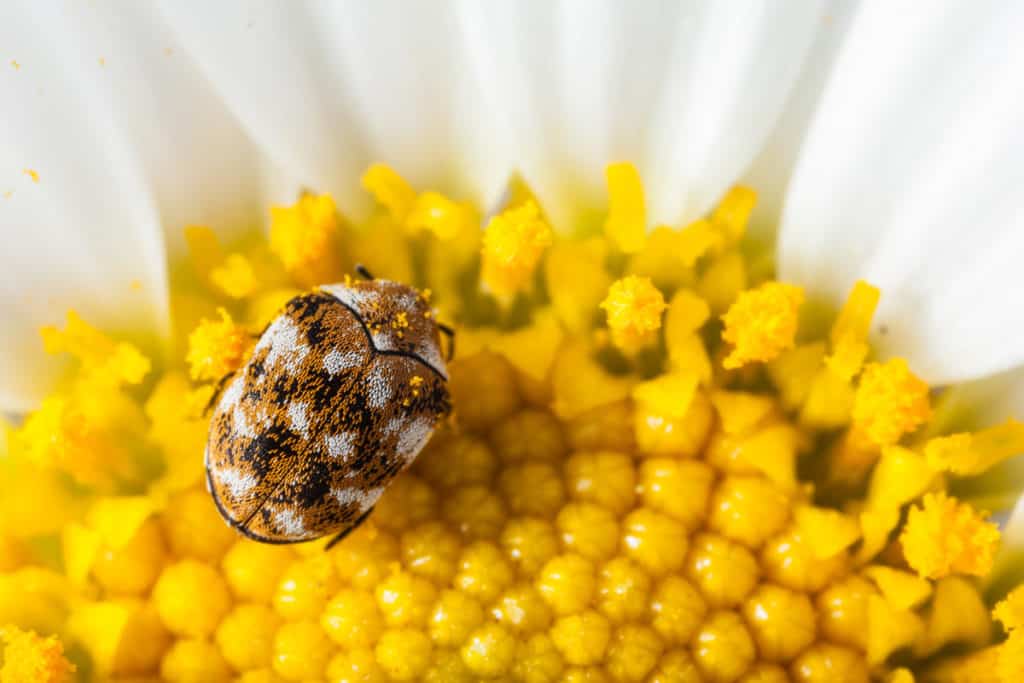
Included but not limited to this category are the following: buckwheat, crape myrtle, and spiraea.
Add to that their love of flowers and seeds and it’s easy to see how cutting a bunch of fresh spring or summer blossoms can lead to a number of them suddenly taking up residence in your home.
And even though they don’t live very long, typically less than one year (although a lucky few do make it to the third year mark), they’re capable of causing a fair bit of damage to your wardrobe.
This is because they can lay loads of eggs, approximately 100, making any number of them in your house a bad idea.
Especially since their larvae which have giant appetites only take about two weeks to emerge. This stage during which their reign of terror begins is actually the longest part of their lives and may last anywhere from three months to two years.
If you are wondering carpet beetle leave poop behind, check out this article we have written. Do Carpet Beetles Poop And What Does It Look Like?
These hirsute tiny crawlies are colored with alternating bands of cream and brown and have plump spiky bodies.
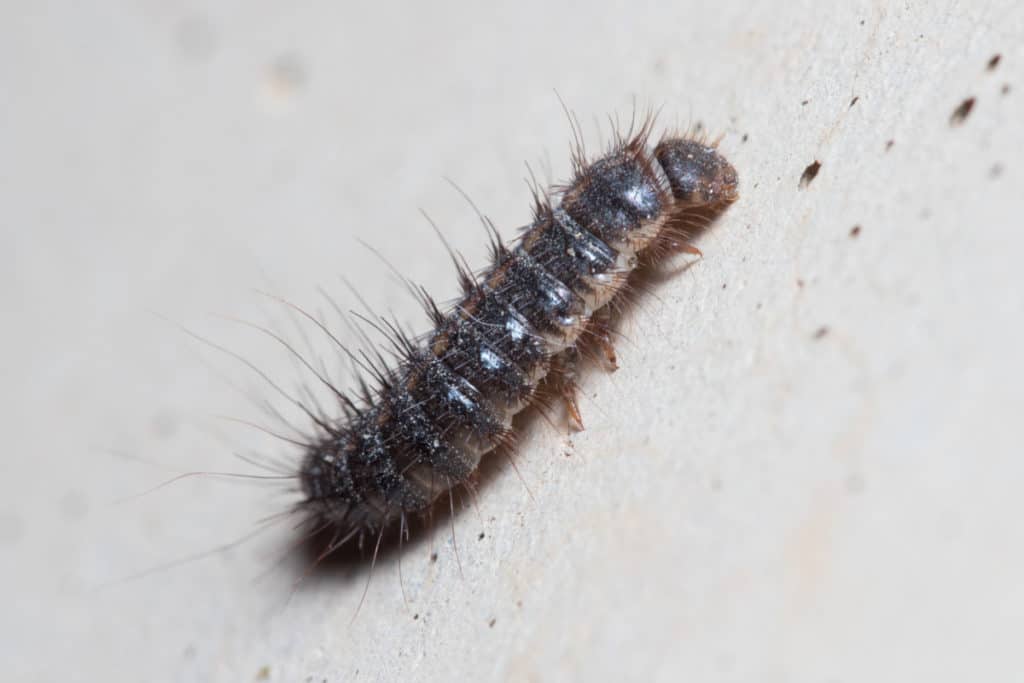
Their maximum size is about four millimeters long, however, larvae of certain species such as the black carpet beetle have been known to reach over a centimeter in length.
They make up for that miniature size with their ability to feed on copious amounts of dried animal and occasionally plant matter away.
Yes, unlike their herbivorous parents, carpet beetle larvae are omnivores with a very strong preference for animal matter.
Nothing is off-limits: wool, silk, leather, hair, felt, feathers, and fur (including your pets’), and even sweat-drenched cotton or linen will do nicely for a starving carpet beetle larva.
Worst of all is the fact that it will chew little mazes through pullovers, scarves, socks, and household linen in what seems to be an unending quest for a full belly, causing a significant amount of damage in the process.
It will also help itself to any dried food crumbs and might even decide to feast on your pet’s dried food where possible.
Yet the one thing they won’t do is bite you given their marked preference for moisture-free stuff.
However, they can cause you and your pets a certain amount of discomfort as seen below.
So we have a pretty good idea now of what carpet beetles like to eat, but how do they get into your house? What causes carpet beetles? If you are interested in a detailed answer to this… Then you are in luck, we have written an article called, What Causes Carpet Beetles? What Should You Watch Out For?
Carpet Beetle Larvae And Your Skin
As noted above, carpet beetle larvae can feast on everything from fabrics, human perspiration to sebum. So it’s hardly any surprise that they occasionally find their way into your clothing and bed linen.
And that’s where things can get dicey. Contact with carpet beetle larvae or the spiky hair and molts they leave behind can trigger an allergic reaction in certain individuals.
This can occur with even freshly laundered clothes or bed linen that have been left for a while in wardrobes or cupboards in which one or more of these little wrigglers have taken up residence.
We have another article with more detail on how harmful carpet beetles can be. If you are interested check it out, Are Carpet Beetles Harmful?
So What Does It Feel Like?
The allergic reaction carpet beetle larvae cause has been described as feeling itchy and painful, with the latter sensation being somewhat more prominent than the former.
Treating Carpet Beetle Larvae Reactions And Insect Bites
Whether you are allergic to carpet beetle larvae or have been bitten by any of the bugs mentioned above, you will most likely experience pain and itching.
Home remedies and over-the-counter treatments are both quite efficient when it comes to providing you and your pets with the relief you need. Some of the most popular examples include:
- Calamine Lotion
- Benadryl Cream
- Natural Remedies
- Painkillers
1. Calamine Lotion
An excellent choice of relief in this regard, this cooling pink cream is an exquisite blend of zinc oxide and zinc carbonate (or ferric oxide). Calamine lotion not only possesses astringent qualities but will also allay any itching and even provide antibacterial protection. However, it’s unsuitable for pets since it contains zinc which can be dangerous if ingested by canines.
2. Benadryl cream
This famed antihistamine is also another thoroughly effective choice that is capable of providing prompt relief.
3. Natural Remedies
Awesome home remedies that will provide fast relief include oatmeal paste, calendula oil, coconut oil, tea tree oil, vinegar, or aloe vera.
The wonderful thing about home remedies is that they can be used on your pets. However, special care must be taken with tea tree oil which is toxic to dogs.
4. Painkillers
To relieve any pain as a result of bites or allergies, remedies such as Ibuprofen, Tylenol, or Paracetamol will help.
It’s slightly trickier with pets since vets warn against administering pain killers to them without the advice of a veterinarian.
You should also avoid administering painkillers relied on by humans such as those mentioned above or even aspirin since they can be harmful to your pets.
How To Handle A Carpet Beetle Infestation
Spring Cleaning
To get rid of carpet beetle larvae, you will need to ensure that your home is spotless.
As a result, you will need to wash every bit of household linen and clothing, including blankets and clothing used by your pets, on the hottest possible cycle. You will also need to dry them in the highest possible setting as well.
Relying on elevated temperatures during this process will significantly reduce the likelihood of any insects or their eggs, making it out unscathed and ready to take on your entire household once more.
You will also need to vacuum your floors, carpets, rugs, and upholstery thoroughly and steam clean them where possible.
Window ledges which are a favorite spot for carpet beetles to gather will also need to be checked and vacuumed to remove them.
Once your clothes are dry, you will need to store them in airtight containers and also use mothballs to keep any insects away.
Any dry pet food which has been infected will have to be thrown away and any dry food packets which are subsequently opened will also have to be carefully stored in air-tight containers.
What should you do if you still find a few carpet beetles or larvae, crawling around your home?
You will need to call on a pest control company to ensure that you put an end to their invasion once and for all.
Personal Hygiene
In addition to cleaning your surroundings, you will also need to turn your attention to both human and furry residents in your home.
Ensuring everyone’s locks undergo a thorough treatment with anti-lice and tick shampoo and body wash should see your family free of those troublesome little bugs.
Your felines and canine friends shouldn’t be left out either.
Shampoos and ointments can be used to soothe itching from carpet beetle larvae.
As with the case of your home, any stubborn persistence of these insects will require the assistance of a health care professional or a veterinarian to ensure relief from itching, soreness, and possible infection.
Carpet Beetle Larvae Vs Bed Bugs
Bed bugs are another category of unwanted house guests known to cause itching and pain. Unlike carpet beetle larvae which prefer a bit of variety in their diet, bed bugs need just one food source to get by…..blood.
Their mouths are specially adapted to pierce the skin and draw out the crimson fluid. (In the absence of any humans, they may decide to get their daily dose of nutrition from any pets in the vicinity. That said, humans are much more preferable to them since they dislike fur.)
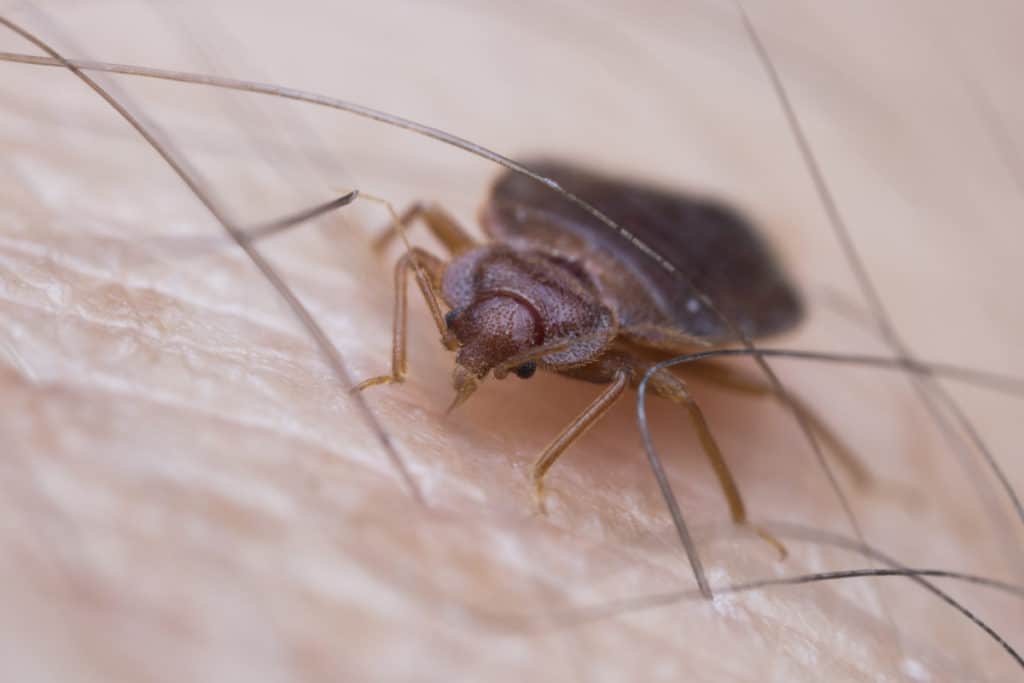
However, most people tend to confuse allergic reactions with an infestation of carpet beetle larvae with bites from these little critters.
Telling them apart is pretty easy since bedbugs are generally the size of an apple pip, and are pale or reddish-brown. (However, young insects can only be spotted with the aid of a magnifying glass and are virtually transparent.)
Their bites which are painless initially can result in raised bumps that resemble mosquito bites and are quite painful and itchy.
Allergic reactions caused by carpet beetle larvae, on the other hand, tend to resemble a cluster of tiny red bumps that may be spread out over a large area of skin.
Other Insects Worth Looking Out For
Bedbugs and carpet beetle larvae are by no means the only critters that can cause a bout of redness and painful itchiness. Other insects leap at the opportunity to burrow into your bed linen and clothes to take a nourishing bite out of you, your family, or your pets.
These include:
- Lice
- Ticks
- Fleas
1. Lice
Like bed bugs, they rely on blood for sustenance (although they do help themselves to some dander as well). And just like them, their bites also tend to go unnoticed since they are also painless.
However, that’s where the similarity ends. Unlike bedbugs which are larger, lice are the size of sesame seeds and are somewhat greyish or white.
Unlike their far more resilient parasitic counterparts, which are capable of remaining without food for long periods, lice need their daily dose of sustenance.
They also prefer to remain right where their food source is and so live on humans, hidden in all that hair, where they work hard at feeding and reproducing.
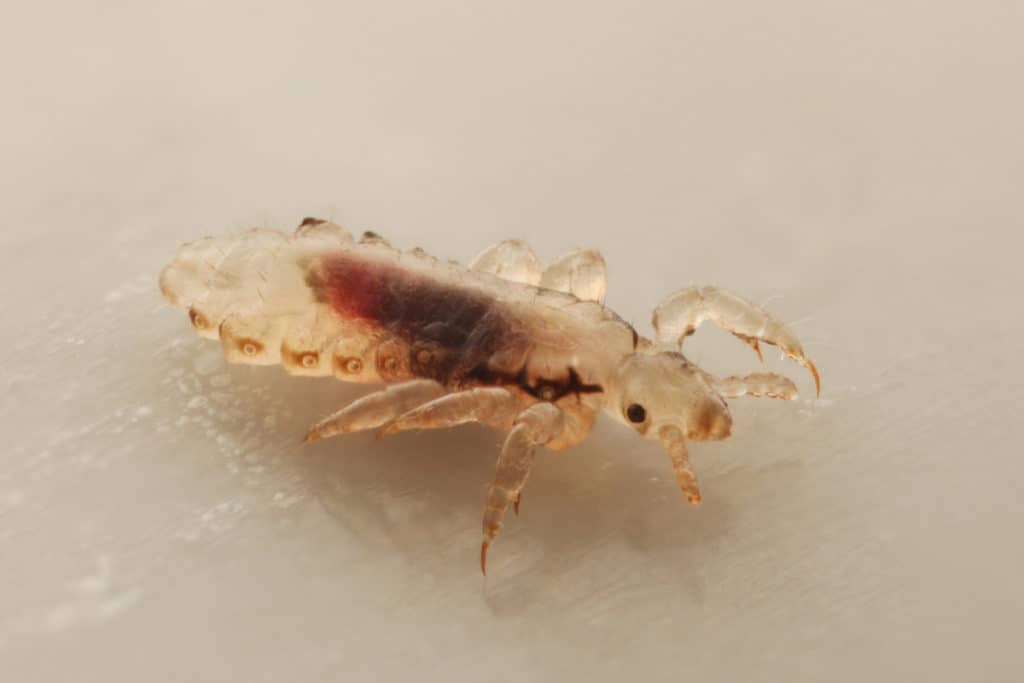
They also like pets of the furry and feathered variety. However, those that do, stay away from humans, and those who prefer humans avoid canines, felines, and avians as well.
In addition to the unpleasant itching caused by their saliva, lice can cause infections such as typhus fever, for example.
2. Fleas
The most agile of the bunch, fleas are fond of both humans and pets. However, they strongly prefer the latter due to the warmth and concealment they provide.
While they may decide to hide in your clothes for a while, they will leap onto your pet labrador at the earliest given opportunity.
These athletic insects are rather minute and reddish-brown; unlike lice and bed bugs they cause pain when they bite. And then there’s that troublesome itching which follows as well.
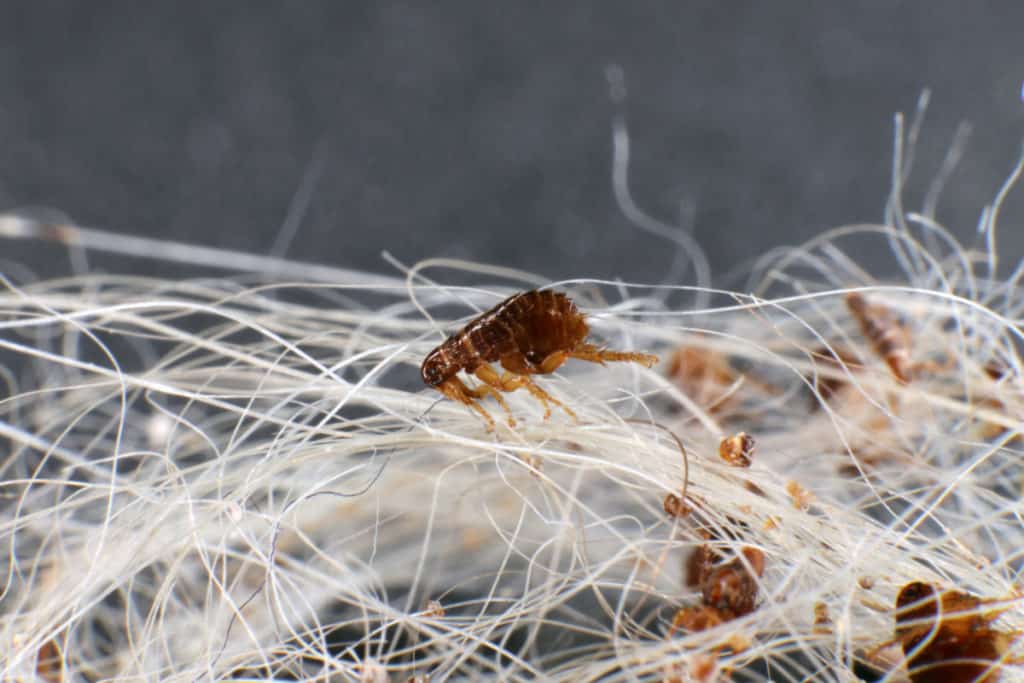
Fleas tend to leave rashes behind once they’re done feeding. And just like lice, their bites can transmit much more than discomfort and are capable of causing typhus and flea tapeworm infections.
A couple of sinister facts about fleas include the fact that they can actually invade a house that doesn’t have any pets and that there are probably 100 youngsters hanging around for every one you spot.
3. Ticks
Like the rest of the villains of this tale, ticks are arthropods. And like fleas and lice, they also rely on the blood of humans or animals to survive.
However, unlike all the others, ticks are arachnids. That’s right, they possess eight legs and may be considered to be related to the most famous of the bunch: spiders.
Ticks love to lie in wait on a blade of grass with their arms out in the air patiently waiting for you or your pet to pass by.
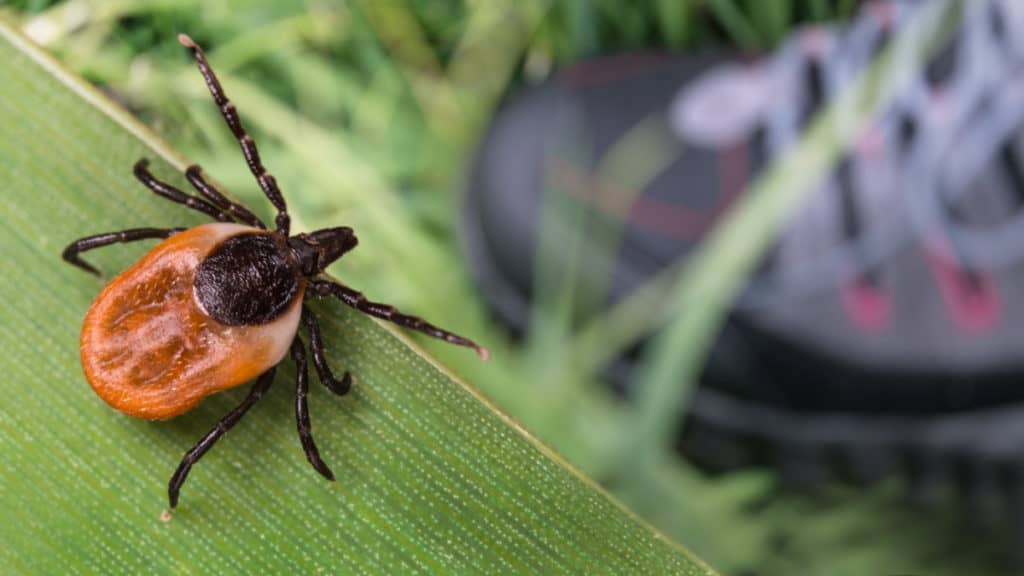
Once they’re able to hitch a ride, they begin to feed. A well-fed tick can get pretty large and some of them have been known to swell to the size of a marble.
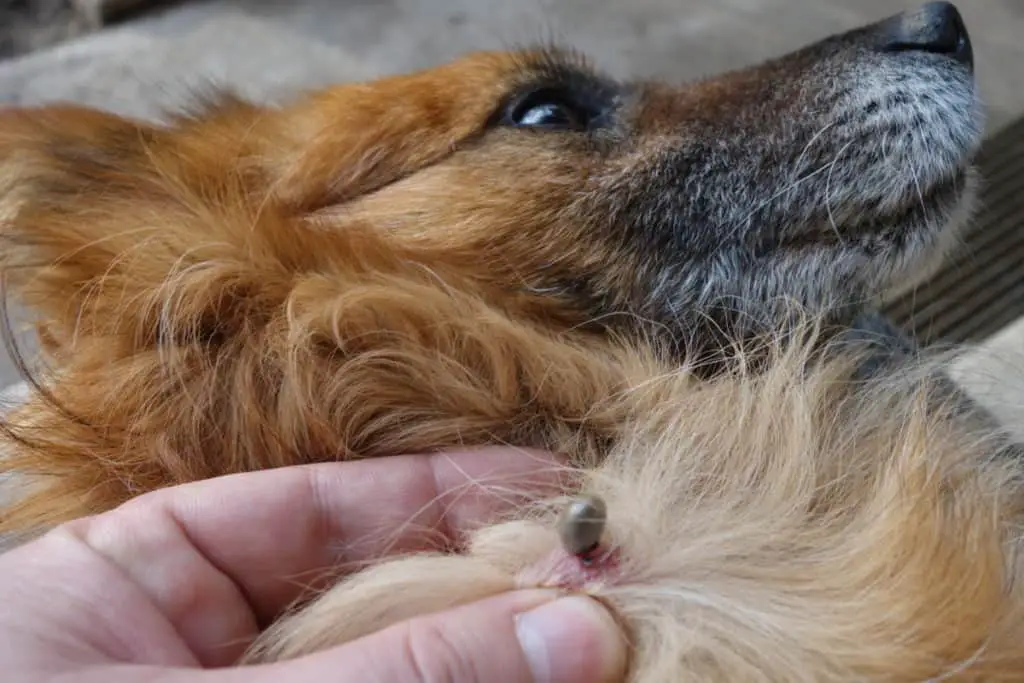
Because their saliva prevents their victim from feeling pain and doesn’t cause any itching or swelling, they’re pretty hard to detect.
In terms of appearance, their bites look just like those of any other insect.
Ticks are also extremely resilient: they can last for two years without any food and can survive for about two or three days underwater.
Is it possible for you to infect your furry friends or for them to infect you?
Absolutely. Ticks are by no means fussy about their host and will move from one to another when presented with the opportunity.
They also carry a plethora of diseases — about 16, meaning they beat out the humble mosquito in this regard.
Examples include Lyme disease, anaplasmosis, ehrlichiosis, and Rocky Mountain spotted fever.
The Wrap Up
Carpet beetles are far from menacing in their adulthood-it is as larvae that they are likely to be a pain in the neck (sometimes, literally).
However, the one thing they’ll never do is bite.
Therefore any itching or redness may mean you are allergic to them and have come in contact with them, their hair, or their molts.
These symptoms may also indicate the presence of certain parasites such as lice, fleas, or ticks.
Thankfully, home remedies and over counter medicines, and shampoos for both humans and pets abound.
And with prompt action and thorough spring clean you are likely to be able to enjoy a happy, healthy household once more.
And if need be, you can always rely on professional pest control and medical help to ensure that you, your family, and your furry friends, and not the bugs, get the upper hand at the end of it all.
Sources
https://hgic.clemson.edu/factsheet/controlling-fabric-pests/
https://www.who.int/water_sanitation_health/resources/vector237to261.pdf
http://entnemdept.ufl.edu/creatures/fabric/black_carpet_beetle.htm
https://www.medicinenet.com/flea_bites_in_humans/article.htm
